

By the book
In our annual summer reading edition, we take a look at what local authors have to offer to help fill the last, lazy days of the season.
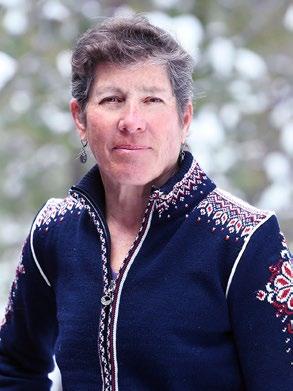

Photo Provided
Tahoe local Susan Norman is the author of Risk: A Life Saved by the River.
Serving Lake Tahoe’s South Shore Since 1994


















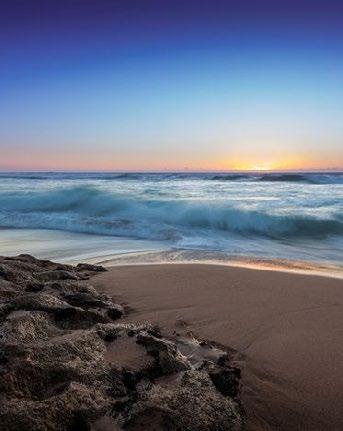




DUNLAP AVE AT THE “Y”

NATURALFOODS MARKET
Groceries,
SCAN


Last month, I went on a family trip to the coast. We stayed at a place that—gasp!—had basically no cell service of any kind. In between hiking along the shore and eating really good seafood, I had time to fill. I had brought along some magazines and books and I cracked open the book I was reviewing for this month’s annual summer reading edition (see page 17) and got started. I read sitting in the beach chairs out front, I read slouched on the couch, I read in bed before going to sleep. It was one of the most relaxing, pleasurable experiences I’ve had in a long time. It reminded me of childhood summers spent at my family’s backcountry Wyoming cabin —which actually had a library—losing myself in transporting stories and tales in the hammock or on the sun porch in the summer or in front of the fire or under the covers in the winter.
I still read books in my everyday life, today, but not with such abandon and surrender to the printed page. There are chores and work and duties and responsibilities that interrupt—and there’s my phone and the internet.
While the World Wide Web takes me places I wouldn’t have imagined—I never knew so much about so many things—it’s the constant texts and emails and posts and alerts and calls that keep one tethered and unable to disconnect and just experience life offline. And let’s face it, scrolling is a poor substitute for turning a page.
The place where we stayed on the coast had a bookshelf full of books—one member of the party chose the Rachel Carson classic Silent Spring, which he’d heard about but never read—a box full of classic vinyl records and a record player and a stack of board games. We had so much fun and after an initial withdrawal, didn’t miss our phones at all.
I am able to connect with friends, neighbors, colleagues and a host of others on my phone—it’s quicker and easier, but I’m not sure it’s better. When I used to visit my grandparents as a kid, I remember every day, mid-tolate morning, the neighbor ladies from the block would gather at the house. With a quick knock on the door and
a “yoo-hoo,” they would come into my grandmother’s kitchen where for an hour or so they would all drink coffee and gossip, share, listen, debate, advise and support each other. After hours, my grandfather and the other neighborhood men would help each other with projects, play horseshoes, drink a beer and talk politics. NextDoor can’t even begin to compare.
The internet can be a lifeline for those who are isolated or marginalized in their communities, but I still have to say, it’s like Wonder Bread compared to a freshbaked, artisan loaf. I like to think of the Mountain News as a good book or an artisan loaf of bread our readers can savor. Slow-baked stories with detail and meaning, columnists representing the ingredients that make up our community and of course the occasional fun pop of flavor. So grab a summery drink, find a seat in the sun, and dig into our pages.
One of the largest selections of organic produce at Tahoe
Complete selection of vitamins, supplements & herbs

NEED REHAB? TRAIN SMARTER, NOT HARDER!
Blood flow restriction (BFR) training is a technique where you lightly restrict blood flow to your limbs during low-weight exercise to help build muscle and strength.
After surgery, lifting heavy isn’t possible — but with BFR, you can train at just 20–30% of your max and still gain strength and muscle.
Ready to begin? Contact us today to get scheduled!
SCAN TO LEARN MORE



“What happened to the transit authority formed by South Lake Tahoe and El Dorado County?”
– PB

South Lake Tahoe and El Dorado County electeds in 2024 voted to create the South Tahoe Transit Joint Powers Authority because they believed the Tahoe Transportation District was not providing adequate or efficient public transit to their respective jurisdictions.
The Mountain News wrote all about it in May 2024 (https://tahoemountainnews. net/past-issues/may-2024/).
Last fall the City Council voted 5-0 to go forward with the JPA, with EDCo. supervisors voting 3-2. Two of the three who were in favor are no longer on the board— one died, the other didn’t run again.
In April, start-up funding for the transit JPA was before the supes. It was scrapped on a 4-1 vote, with Supervisor Brooke Laine the lone supporter.
“It was quite a surprise for me that they were so off the cuff comfortable to break the contract with the city, that they were not going to do the financial lifting,” Laine told the TMN
She said the vote denied a $50,000 allocation that would have funded one-third of the JPA through this September as well as $110,000 for another year of funding which would have given the entity power to apply for federal funding.
“We could have grown transit in the city and the county,” Laine said of the waylaid JPA.


stipulates microtransit be provided and vehicle miles reduced.
While Lake Link serves segments of Douglas County and South Lake Tahoe, it does not go into the unincorporated area of El Dorado County. El Dorado County residents have access to paratransit, which TTD must legally provide to comply with the Americans with Disabilities Act.
It’s obvious public transit on the South Shore is not meeting the needs of the public or satisfying those who make the decisions. People needing to get places don't see a state line. They cross it every day for work, to eat, to shop, to play. While many politicians are frustrated, they aren’t the ones who need or even want to ride the bus. However, it is their job to provide functional public transit for everyone on the South Shore—no matter the state line.
Email: mountainnews2@gmail.com Mail: P.O. Box 8974, South Lake Tahoe, CA 95618.
The Tahoe Regional Planning Agency serves as the TMPO (Tahoe Metropolitan Planning Organization). As such, it receives the transportation dollars from the states and federal government, and then passes that money on to TTD.
It’s those dollars that the city-county JPA wanted to tap in order to keep California dollars in California.
Even so, Laine is willing to share.
“As long as all of our needs are being met, I don’t have a problem with money going in one big pot,” she said.
The JPA technically still exists because neither the city nor the county has terminated the agreement. Because the JPA board adopted a regular meeting schedule for this year, notices still go out. The emails simply say the meeting is canceled.
“The City Council has requested that city staff provide them with an update on the JPA status, which is planned for the Aug. 26 budget workshop,” Assistant City Manager Hilary Roverud said. “At that time the council may provide direction that could answer some questions about the future of the JPA and issues the JPA board was working to address.”
It’s not just California electeds disregarding the “there is no state line and we are one community” mantra.
TTD has been operating transit on the South Shore since August 2010 when the South Tahoe Area Transit Authority filed for bankruptcy. STATA was comprised of public and private entities including local governments, casinos, Heavenly Mountain Resort and Ridge Tahoe.
Douglas County commissioners in July approved a three-year agreement with TTD microtransit service on the South Shore. Douglas electeds want the money to stay in Nevada.
The Tahoe Douglas Visitors Authority had been the recipient of those taxpayer dollars. TDVA owns the Stateline event center. A condition of the permit issued by TRPA


Photo Kathryn Reed
While Tahoe Transportation District buses say “Connecting Our Communities” that isn’t really what’s happening.



Publisher’s note: This is one in a series of stories written by immigrants living on the South Shore. Names are withheld to protect the individual who wrote it and that person’s family.
For immigrants in the Tahoe basin, even permanent legal residents, these are frightening times. Though Immigration Customs and Enforcement (ICE) has thus far made only a limited number of arrests in South Lake Tahoe, its agents are cruising quietly around town.
We have to assume the pace of detentions and deportations will pick up in the months ahead.
Though we prefer to keep ourselves anonymous in this article, a number of us— immigrants as well as U.S.-born citizens—have organized to support those who are threatened and to carefully document ICE activities in real time.
Our goal is not to interfere with or obstruct immigration enforcement. Rather, our goal is to keep track of what is happening and make sure ICE agents know that people are watching if they act outside the bounds of the law. To that end, our volunteers can and will document agents if they interrogate and arrest local residents.
We record their activities on video, and we take written notes on as many details as possible.
In addition, our members provide as much support as possible to people who feel threatened. Though most of us are not attorneys, we can provide practical guidance on what to do when confronted with immigration agents or local law enforcement.
If someone knocks on your door and says “police,” for example, you should not open the door unless that person can provide a judicial warrant signed by a judge. ICE agents frequently resort to “administrative warrants” issued by their agency, but those do not give them the authority to enter or search homes without permission.
Why are we doing this? Perhaps the most important reason is to remind our immigrant residents that they are not alone.
South Lake Tahoe has long had a vibrant and productive immigrant population, which contributes mightily to our economy and to
We are watching




our social fabric. We all know immigrants in a host of ways— as friends, family members, neighbors, co-workers and even business owners. The hotels, casinos, restaurants and ski resorts couldn’t function without immigrants from around the world.
More fundamentally, we care deeply that everyone here is treated with respect and dignity. We are supposed to be a welcoming community, and we think it’s horrifying to see people targeted as possible criminals simply because they speak with an accent or have brown skin.
Unfortunately, we know all too well that the Trump administration has been willing and even eager to trample over basic civil rights. They have arrested and tried to deport legal residents who had no criminal record whatsoever. They have arrested and tried to deport people like Mahmoud Khalil, the doctoral student at Columbia University who has a “green card” and is married to an American. They flouted a judge’s orders and flew hundreds of migrants to a brutal prison in El Salvador. Many of them had no criminal record whatsoever.
They also wrestled to the ground one of California’s U.S. senators, Alex Padilla, when he tried to ask a question of Kristi Noem, the secretary of Homeland Security.
They have detained several American attorneys who are full U.S. citizens.
It’s important to remember that the U.S. Constitution protects basic civil rights—notably the right to due process—for any person in the United States. It doesn’t simply protect citizens.

Over the last several months, those of us who care about these issues have gradually built expertise in tracking local immigration enforcement. We have all taken training from NorCal Resist, which operates throughout Northern California, on how to provide support for immigrants while always staying within the law ourselves.
If we get word that ICE vehicles appear to be driving around town, or gathering at a staging area, several of our volunteers will drive to where the activity took place.
ICE agents know they may be unwelcome in many communities, so agents often drive in unmarked cars and don’t wear uniforms. If they suspect someone is following them, they often take evasive action. Our efforts sometimes have the feel of a wild goose chase.
Despite that, we have documented ICE activities in South Lake Tahoe. One of our volunteers spotted an unmarked SUV, as well as a large white van with Homeland Security license plates. Shortly after that, another volunteer glimpsed the SUV and the white van as they led a small caravan of cars into a local parking lot. That volunteer then watched and took photos of men pulling
equipment out of their trunks. She also took photos of the license plates.
Needless to say, the officials being photographed weren’t happy. At least one started taking video of our volunteer and insisted that she had no right to be there. Our volunteer politely stayed in place, pointing out that they were all in a public parking lot. Within a few minutes, the apparent agents gathered their things and drove away.
We have learned that federal agents are often as afraid of local citizens as members of our immigrant community are of them. That’s why the agents often wear masks. They know how unpopular these immigration roundups often are.
Was this a waste of time?
Not at all. This is our way, and it’s an important way, to let people know they have real community support.
Beyond that, we have developed increased practical
expertise. We now have a communication system that allows our volunteers to hold an encrypted conference call while they’re driving. They can compare notes and photos, as well as distribute photos of vehicles and license plates in real time. We have become much better at spotting activity when it’s still at the early stages. Our goal is to keep the feds on their best behavior, and the best way to accomplish that is to make sure they know that the eyes of the world are on them. To us, that’s what democracy is about.
We welcome new volunteers. Anyone who wants to join us may reach us through NorCal Resist (https://www. norcalresist.org/) to sign up for their online Migra Watch training. The email address is NorCalResist@gmail.com or call (916) 382-0256.
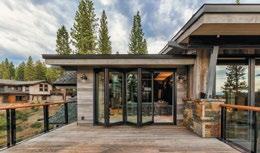







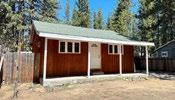


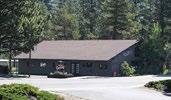


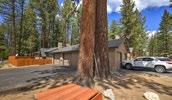

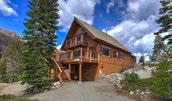













Chopping It Up with the Mayor featuring South Lake Tahoe Mayor Tamara Wallace and City Manager Joe Irvin debuted in the spring with seasonal episodes planned through the end of the year. The show stars the
website and Facebook page. “We’ll be tracking the views, seeing how much engagement there is, listening to comments from the community,” said Irvin.
The cost of the planned four-episode show is included in the city’s contract with SoSu.TV, which films, posts and broad-
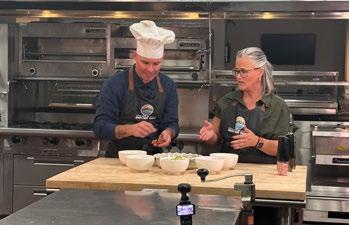
recipe—the first was lasagna soup—and sharing city news.
Irvin, who lifted the idea from a city manager friend in another jurisdiction, called the show “kinda cool,” and said the goal was to “meet the residents, the business owners, the constituents where they’re at.” With more and more people getting news and information online and the popularity of cooking shows in general, it seemed like a good way to draw interest and get the word out about city happenings.
The first installment was almost 12 minutes long and interspersed footage of the pair preparing the soup with reports of improvements to city facilities, often with somewhat corny lead ins. A quip about not burning the food and setting off the fire alarm introduced a segment on upgrades to Fire Station #1. The information highlighted was positive and non-controversial. No talk of divisive city topics like VHRs or the Heavenly annexation.
So far, the initial episode has been viewed 323 times on the city’s YouTube channel and received 11 thumbs up and no thumbs down. It also runs periodically on Channel 21, the city’s television channel, and can be accessed through the city’s


casts city council meetings, various city commission meetings and other official events. As part of that contract, SoSu. TV receives $30,000 annually to develop and produce original content for the city.
Chopping It Up with the Mayor is filmed at the Lake Tahoe Community College culinary arts kitchen
So, most importantly, how is the food? I prepared the lasagna soup and found it kind of meh. It tasted fine, but not scrumptious. The flavors were rather muted. After a night in the fridge, I heated it up in the microwave for lunch the next day and found the flavor, as is the case with many soups that sit for a while, vastly improved.
The second episode dropped just as we were going to press, so I didn’t have the time to test the recipe—garlic butter roast chicken and ratatouille, Wallace’s own family recipe. The newsy portion of the episode featured wildfire preparation and defensible space.
The addition of Cajun seasoning to the ratatouille seemed an inspired riff, but the elimination of eggplant (Wallace said no one in her family likes it and she subs in sweet potato instead)? Culinary blasphemy. Time to storm city hall!
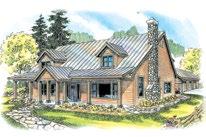

Photo Courtesy City of South Lake Tahoe
South Lake Tahoe City Manager Joe Irvin and Mayor Tamara Wallace star in Chopping It Up with the Mayor.
The Lake Tahoe Visitors Authority is inviting local non-profits to apply for funds from the $85,000 raised for local causes at this year’s Celebrity Golf Tournament. The deadline is August 25. Access the application at https://visitlaketahoe. com/media-and-pr/85000-for-tahoe-areanon-profits-from-american-century-championship/ Youth, environmental and community service causes will be prioritized.
During the tournament, $10,000 was donated toward the new Rec. Center, the $10,000 Gene Upshaw Memorial Scholarship was awarded to LTCC student Yuliana Rosales and $10,000 was donated to South Lake Tahoe Football Boosters.
Save Mart is going in at the site of the old Rite-Aid at the corner of Al Tahoe/ Highway 50. Construction started in July, with a worker saying it will take six to eight months to transform the gutted site.
Visitors may hear chainsaws and see heavy equipment and some trails may be rerouted for safety at Van Sickle Bi-State Park as forest health projects get underway, setting the stage for future upgrades.
Dr. Andrew Latimer will give a lecture on fire risk, fire behavior and post-fire forest resilience in light of climate change at Granlibakken Tahoe on August 15 at 6pm (doors open 4pm), presented by the UC Davis Tahoe Environmental Research Center. Tickets $10 through Eventbrite, $15 at the door, students free.
Sierra at Tahoe has a new avalanche rescue dog in training. Yuki a nine-weekold golden retriever will hit the slopes this winter.
Bike Tahoe has launched the 2025 Bike Tahoe Film Fest seeking amateur filmmakers showcasing local biking adventures. The five categories to choose from are Bike Park, Family Affair, Next-Gen, Awe-Inspiring Beauty and Extreme Adventure. Submissions accepted through Octo-
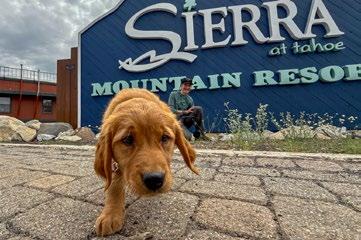
ber 15. For more information, visit www. BikeTahoe.org.
The annual Father Grace Memorial Golf Tournament will be held September 4 at Lake Tahoe Golf Course. To sponsor, participate or for more information, call Dannette at 530/545-2221 or visit www. tahoecatholic.com/golf2025.
Barton Health has become a member of Cleveland Clinic Connected, which will offer Barton care providers cutting edge educational opportunities, guidance on best care practices and protocols, and training opportunities. Cleveland Clinic Connected will also partner with Barton on designing and equipping facilities in ways that improve patient outcomes.
Drinking beer at the 8th annual Tahoe Brew Fest on August 23 along Ski Run Boulevard will benefit Boys & Girls Club of Lake Tahoe
The California Tahoe Conservancy under Gov. Gavin Newsom’s emergency wildfire proclamation will be reducing hazardous fuels on 43 acres of Conservancy and U.S. Forest Service properties, including large parcels adjacent to the Tahoe Keys. Sample the Sierra is September 6 at Bijou Community Park in SLT.
On the first and third Wednesdays of the month from 8am to noon and 1pm to 4pm, Barton Health offers free blood pressure checks at 2170B South Ave., South Lake Tahoe.
Petal Kindness, the nonprofit that gives flowers a second life by providing them to charities, hospitals, senior centers, and community-based organizations is in need of vases. Drop them off at 2941 Lake Tahoe Blvd.
Zephyr Cove Library has an ongoing book sale in the lobby, with proceeds reinvested in local programs.
Sugar Pine State Park is returning the names of General Creek Campground
and General Creek Loop Trail to their traditional Washoe name, dukMéɁem wáťa (dook-MEH-em wah-tah), which means Wave Creek.
California is the No. 1 state for hiking according to KURU Footwear, with the Sierra being part of the reason.
The National Interagency Fire Agency is predicting above normal wildfire activity in August for a large swath of California, including the entire Lake Tahoe Basin. This evacuation checklist (https:// shorturl.at/hUlUQ) may be helpful no matter the reason for leaving.
South Lake Tahoe native Nico Wagner a right-handed pitcher, was selected in the 16th round (No. 487th overall) by the Atlanta Braves.
Music on the Beach, the annual fundraiser for Tahoe Arts Project, is August 25, 6pm to 9pm at Lakeshore Lodge & Spa.
Suggested donation is $20.
South Lake Tahoe Ice Arena will be closed through September 15 for essential upgrades to improve energy efficiency and reliability at the arena. This will be the first time the ice will be removed since the rink opened in May 2002.
Nevada Department of Transportation wants kids in grades K-12 to participate in a walk and bicycle safety art contest One winner’s art will be featured on a Carson City mural. For more info, email kristen. marshall@dot.nv.gov.
The UC Davis Tahoe Environmental Research Center has launched a drone program to monitor and study algae around Lake Tahoe. To donate in support of the program, visit https://www.givecampus.com/campaigns/49377/donations/ new?appeal_code=26076&hide_appeal_ code=1&designation_id=325421&designation_id_1=tercg53&designation_ id_2=tenvgft&amt=100.00
The state of California is offering free
radon testing kits for residents of Sugar Pine Village. Radon is a naturally occurring gas that can cause lung cancer. Email Jeff Miner at jeffminer3@gmail.com or text 530/416-2180 to obtain a kit.
The last concert of Tahoe Paradise Park’s summer music series is September 7 at 3:30pm. Featured act: Boot Juice
Zephyr Cove Elementary School fundraiser, The Way We Gather with themed tables, is August 22 from 5pm to 8pm. Cost, $160 per six-person table. www. zcesparentsclub.org for tix and info. A
A one-day workshop to assist faith leaders in ministering to people affected by suicide will be held August 25 at Zephyr Point Camp and Conference Center. nwheeler@zephyrpoint.org for more information.
The South Lake Tahoe Library hosts a family game night every Wednesday from 4:30pm to 6:30pm. Games available or bring your own.
Rodney Paul, rock historian, will deliver a talk focusing on Jefferson Airplane and the summer of 1967. August 26, South Lake Tahoe Library, 5:30pm. Free.
Environmental attorney Clem Shute, a TRPA founder and longtime board member, received the Dianne Feinstein Lake Tahoe Award at the annual Lake Tahoe Summit on August 6.
Need a night away from the kids?
Drop them off at the South Lake Tahoe Rec. Center August 15, 5:30pm to 8:30pm. Food, fun and more. Cost, $40 per child. Pre-registration required through portal at https://secure.rec1.com/CA/south-laketahoe-ca/catalog, click on “special events.”
Got a community item for Heard? Email mountainnews2@gmail.com, subject line “Heard.”

The South Lake Tahoe Optimist Club would like to thank everyone who participated in another successful DAY IN PARADISE DUCK RACE that was held Saturday July 19th.
We had 14 Business ducks heats this year and would like to thank the following businesses:
Adrian Combs, Aligned Chiropractic, Alpine Carpet One, Alpine Metals, Art’s Transmission, Azul Electrical Supply, Azul Latin Kitchen, Barton Hospital, Base Camp Pizza, Bear Roots Coffee, Beverly of Long Beach, BFD / Key Architects, Blue Alpine Builders, Blue Bird Plumbing, Bob’s Heating, Boys & Girls Club of Lake Tahoe, Bruschetta’s, Caro Construction, Chavez Plumbing, Club Live, Creegan Builders, Cul de Sac Holdings, Dalton Family, Diamond Woodcraft, Divided Sky, DL Masonry, DMF Properties, Doug Rosner, Earth & Stone, Eastern Sierra Engineering, Eliot Building Company, Emerald Bay Bar & Grill, Ferguson Excavating, Fire & Ice, Forest Dodge Construction, Frank Iannetta Roofing, Frank Jones Mobil Repair, GB Drywall, Graybar Electric Supply, Haen Constructors, Handy Smith Construction, Hatch Electric, Heather Ross, Herback General Engineering, Hixenbaugh Family, Hydro Fire, Jalisco Restaurant, Jason Reid DMD, Jensen Precast, Jim Bagan Toyota, KD Builders, Kemper Masonry, Ken’s Tires, Kim Williams, Kunibe Family, Lake Tahoe Architect, Lake Tahoe Golf Course, Lake Valley Fire Dept, Lakeside Beach Patio, Lakeside Park Association, Langenfeld Ace Hardware, Leslie DeTarr, LP Insurance, Lukins Water Company, Mark Klover CPA, MB Construction, McLean Accountancy, Meyers Family Dentistry, Mike Silva, Mountain Valley Floors, Muscat-Feist, Muscat-Reliapro, Nancy Dalton, Napa Automotive, Nixon’s Heating, Norm’s Auto Repair, Off The Hook, Pacific Built, Pape Equipment, Paradise Woodwork, Port a Subs, Pyramid Peak Sports, Radach Constructors, Radach Construction, ReMax Realty, Reno Paint Mart, Richard Jacobson, Richard Vandershire, Ron Fuller Construction, Rosie’s Bootcamp, SD Stone, Shaina Haen Family, Sierra At Tahoe, Sierra Smiles, Sierra Tahoe Dental, Sierra Tahoe Ready Mix, Sierra Valley Electric, Ski Bum Family, Sonney’s BBQ, South Shore Boats, South Shore Glass & Door, South Side Auto Body, South Tahoe Refuse, STPUD-Adrain, Struve Automotive, Tahoe Asphalt, Tahoe Basin Containers, Tahoe Dentists, Tahoe Fence, Tahoe Pool Service, Tahoe Tasking, Tahoe Valley Electric Supply, The Brady’s, The Gear Exchange, Trans Sierra Investments, TW Construction, United Rentals, V&C Construction, Weber-Lucky Duck, Warren Reed Insurance, Western Nevada Supply, White Rock Construction, Whiting & Turner, Zen Builders and Z-Tek Services.
In addition to the Duck Race, we also had an extremely popular and hugely successful silent action. We would like to thank the following businesses / people who made that possible: Alpine Smith, Anderson’s Bicycle Rental, Art’s Transmission, Azul Electric Supply, Bare Roots Coffee, BEJAC, Bert’s Café, Bliss Salon, Bruschetta Fine Italian Cuisine, California Burger Co, Camp Richardson Corral, Casey’s Restaurant, Casto Chiropractic, Chicken in a Barrel, Clearly Tahoe, Cool Beans Creamery & Deli, Cuppa Tahoe, Earthwise Pet Nutrition & Wellness Spa, Elements Eatery & Bar, Eloise Automotive, Fire & Ice, Five Star Auto, GaiaLicious Boutique, Getaway Cafe, Goodfella’s Pizza, Heavenly Lake Tahoe Vail Resorts, Henderson Family, Holiday Market, Jim Bagan Toyota, Ken’s Tire Center, LaPosada Real, Lake Tahoe Blue Wave Cruises, Lake Tahoe Golf Course, Lakeshore Lodge & Spa, Lakeside Termite & Pest Control, Langenfeld Ace Hardware, MacDuff’s Public House, Magic Carpet Golf, Marcus Ashley Gallery, Mark Cutright Photography, Meeks Lumber – Tahoe, Meeks Lumber – Meyers, Napa Auto Parts, Pape Machinery, Pet Station, Port of Subs, Premium Disc Golf, Primo’s Italian Bistro, Zao Reid, Raley’s, Riva Grill, Sierra Alternators & Starters, Sierra At Tahoe, Sierra Nevada Backflow, Sierra Valley Electric, Ski Bum Family, Inc., Ski Run Boat Co, Sonney’s BBQ, South Lake Brewing, South Lake E-bikes, South of North Brewing Co, South Side Auto Body, Sports LTD, Steamers Bar & Grill, SUP Tahoe, Tahoe Blue Vodka, Tahoe Bros Charbroiled Burgers, Tahoe Paradise Golf Course, Tahoe Sportfishing, Tahoe Tastings Boat Tour, The Clipper, Tipsy Putt, Trapped in Tahoe, Wilson Public Affairs, Wishes and Dreams Travel, Wyland Art Gallery, and Yugen Cuisine.
HUGE shout out to Luca Genasci, and Lake Tahoe AleworXs for donating the adult beverages this year.
We would also like to give a shout out to the following businesses and people who made this possible: CA Conservation Corp, South Tahoe Refuse, Tahoe Paradise Park, Richard Jacobson, Club Live, Junior Optimist Club, Heather Ross, Rich Vonderscher, Kris Keesling and George Sariego with Tahoe Computer Solutions.

And of course, all the members of the SOUTH LAKE TAHOE OPTIMIST CLUB! Thank you everyone for making this another successful fundraising event and hope to see you next July 18th.


Photo Courtesy Sierra at Tahoe Yuki is Sierra at Tahoe's newest team member.
Last month I invited folks to send info about their home insurance so I could share it back out with you all— if you have had your fire insurance dropped, which company you’re with if not dropped and so on. This all led to looking into becoming a “Fire Adapted” and “Firewise” community, which I’m still doing.
So, to share some reader feedback—first off, I realized how unscientific my data was going to be since I hadn’t accounted for variables like how much replacement coverage you have (vs cost to rebuild) and other conditions. But I’ll mention three examples that at least show how varied the situation is out there.
One homeowner in the State streets still has State Farm and is paying roughly $1,500 this year. They, like many, feel lucky and worry about when it will be cut off. Several of their neighbors have been non-renewed.
Another homeowner between Pioneer Trail and the airport is insured by

AAA and has never been dropped but is paying around $4,600 this year. They note that “the insurance company has lulled us into believing we’re getting a screaming deal.” No argument here. For our part, we were dropped by Farmers a couple years ago, then by SageSure this year and so we find ourselves at the mercy of the California FAIR Plan at around $2,600 plus supplemental policies for earthquake and all things nonfire related, totaling over 4K for the year. And that’s with less replacement value than we had previously.
Those three give you an idea of where most folks seem to fall, with more and more being “non-renewed” and turning to the “fair” plan every year.
What you can do
Well, maybe not much, but the narrative we’ve been sold is that we can help ourselves by becoming a Fire Adapted and Firewise community. Why we need both terms and programs, I still
don’t really understand, but let’s move on.
The difference between a “Fire Adapted” and “Firewise” community
The Tahoe Fire and Fuels Team, a “coalition of local, state, and federal fire agencies, land managers, and other partners working together to reduce wildfire risk and protect Tahoe communities, forests and watershed,” says, “the FAC Program is a comprehensive local network offering resources and guidance for wildfire preparedness, while Firewise is a national program under this umbrella, providing recognition for communities that meet certain wildfire prevention standards.”
According to Michelle McLean, Fire Adapted Communities Program Coordinator, the Tahoe Resource Conservation District coordinates both programs and holds grant funding that allows them to work with all fire districts and land management agencies in the Basin.
Turning to insurance matters
ate Surroundings” and “Structure” protections. Some of these involve having no vegetation and debris under decks, no shed or outbuilding within 30 feet of the dwelling and maintaining an “ember resistant zone” within five feet around the dwelling. In terms of the structure itself, you would qualify by having a Class-A fire rated roof, a noncombustible six inches at the bottom of exterior walls, ember and fire-resistant vents, windows with fire-resistance upgrades (double-paned or added shutters) and enclosed eaves.
A property that qualifies for both discount categories “will receive approximately a 14.5 percent discount on the wildfire portion of their policy premium,” according to the Cal FAIR Plan’s one-pager.
The FAIR Plan says that being part of a Firewise Community can qualify you for an additional ten percent discount on the wildfire portion of your policy’s premium.




There appear to be 46 separate Fire Adapted Communities between Glenbrook and Emerald Bay, but in the Basin as a whole, McLean says there are 100 FACs and 64 Firewise groups. Depending on whom you talk to, the insurance benefits are either significant or paltry.
And because most of us are probably going to end up with the FAIR Plan, I’m basing the following on that plan.
According to the FAIR Plan’s “Discounts-One-Pager,” homeowners can qualify for discounts based on “Immedi-
But still, for the average homeowner, fulfilling all those conditions could take tens of thousands of dollars, especially when you get into roofing and redoing eaves. And given the ambiguous and relatively meager percentages promised, it’s hard to see the logic in pursuing all these upgrades.
However, if you can capture the entire 24.5 percent savings, it might be worth it. You’d need to do the math based on your own situation and future projections.
As always, email mikesmutterings@gmail.com


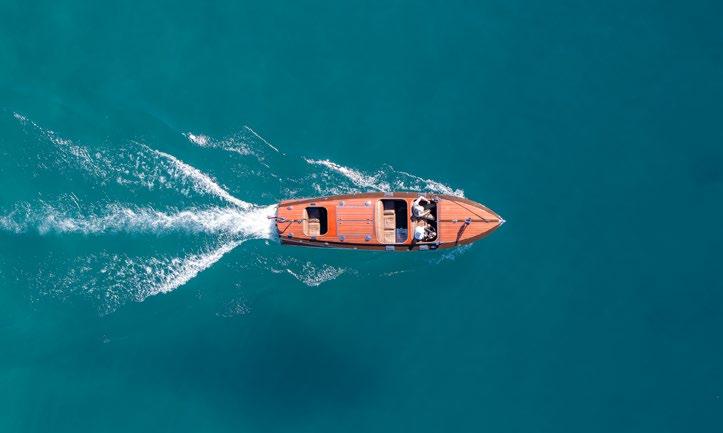
A need for speed defines the latest Owen McKenna thriller Local author faces the currents of life
Speed, Huntington’s disease and sawdust. Three seemingly unrelated elements come together in Todd Borg’s 23rd mystery thriller, Tahoe Speed, creating a flurry of questions and the urgent need for Detective Owen McKenna to get to the bottom of a series of mysterious happenings.
Although this mission appears to be unlike others McKenna has taken on, he steps in. Insurance fraud? A beneficiary denied? These things are not in McKenna’s wheelhouse but Genevieve, a pretty French woman, vulnerable, and needy, calls for his assistance. She struggles with English just a bit, but her charm and intellect speak volumes. Genevieve’s focus is to lift her fledgling French restaurant located in Truckee onto solid financial footing. She hopes to grow her business by boosting her off-season customer base. It’s only been a year since she began this venture.
In the midst of her hard-working efforts, Genevieve’s boyfriend, Colin, is fatally injured in a skiing accident. His death leaves her grief stricken and alone. Then another shock. She discovers she’s the sole beneficiary of his $2 million life insurance policy. She employs Owen
McKenna to investigate the reason she’s been refused payment.
Colin Burns broke the record for speed skiing although he lost his life in the effort. When skiing 160 mph down
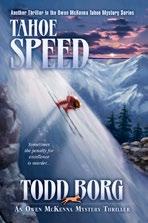
the face of a mountain, falling is not an option. When Colin does fall, there are questions. How did it happen? Something
seems off. As it turns out, Colin was born with Huntington’s disease, a hereditary condition that affects nerves, mood and cognition. Did he know of his condition at the time of his death? He was young and healthy. Typically, symptoms begin between the ages of 30 and 50. It’s possible he didn’t know but still, an unanswered question. But his buddies in the Tahoe Terminal Club — a speed skiing group who delight in skiing down mountains faster than a wingsuit flyer can fall from a cliff — might they have a clue?
What starts out as a mission to find the truth behind the insurance denial veers off into a twisted and complex plot. There are dragons to slay before that initial question is answered. This storyline gives readers an inside peek into the workings of morally corrupt men, pure evil. A moral dilemma presents itself. Do they deserve to live or die? Who decides? Women and their role as members of the police force are also brought to focus. The drama puts a spotlight on their work and dedication as well as their innate ability to make a difference.
Lazlo, a lovable Border Collie, makes his debut in Tahoe Speed He’s found tied to a table outside a restaurant,
shivering in the cold. Of course, Owen McKenna takes him under his protective wing. Street Casey and adopted daughter Camille show great compassion for Lazlo and for Genevieve, a woman who is suffering deep loss.
The action in Tahoe Speed is a bit delayed compared to other McKenna episodes. The prologue is adventure packed, but it’s not until McKenna is almost beaten to death that the drama really heats up. I’m still trying to understand how McKenna kept his injuries so well concealed from his girlfriend, Street Casey. Amazingly, he kept working through his pain and discomfort.
Tahoe Speed is a great summer read. Truckee and the surrounding areas set the scene. Tahoe Speed will leave you to ponder what it might feel like to ski 160 mph downhill without any outside protection — just you, adrenaline and a lot of snow. Enjoy the ride!
Tahoe Speed is available at the Red Hut on Ski Run, Cabin Fever at the Ski Run Marina, the Camp Rich General Store and the Lake Tahoe Museum.
We should all care about tourism and travel
I was not the person the author had in mind when he wrote this book. You might not be either. But that doesn’t matter. There is information on nearly every page that is applicable to any business, government entity, and nonprofit—and all the people who work in those fields.
The relevance to other individuals is going to depend on what you do for a living and how much you take an interest in your local tourism agency. That’s because the book was written for those who are connected to a destination marketing organization, or DMO.
Carl Ribaudo, the main man behind SMG Consulting in South Lake Tahoe, in 2024 published Strategy and Creativity Matter; Notes from the Road: Experiences, Insights, and Perspectives from Along the Way.
Ribaudo has an easy-to-understand way of expressing his thoughts, making this much different from so many business-oriented books. His advice is practical; he explains why he believes things should be done a certain way, what should
be measured, and how entities must adapt to change.
The information is written in story form because it is a collection of previous columns.
The problem with publishing previously published works is that they still need to be updated and not republished verbatim to make the contents relevant for readers on whatever day they read it. So, when it says “last year,” what year was that? I don’t know. I don’t know when the original article was written.
I have two big complaints about the book. The first is that the only place I could find to buy was on Amazon. The second is Ribaudo needed an editor. An editor would have had him either put the original date published on each entry or change time references to the actual date/year or write around it. There are also a few too many typos that distract from the content.
Even without knowing when the articles were originally published or where, I found most relevant to today.
I was interested in what Ribaudo
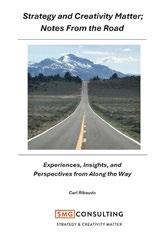
had to say about the need for DMOs to engage the local community, his thoughts on overtourism, and the politicalization of travel destinations.
When talking about strategic planning, this transcends tourism bureaus.
When he talks about strategy vs. planning, technology, social media and so many other topics, all I could think of is that he should be marketing this book to an audience beyond those in the DMO world.
The last part of the book details some of Ribaudo’s exploits on his motorcycle. He’s a man who likes to immerse himself in the world of travel, to talk to the people on the ground, so to speak.
As he wrote in the epilogue, “Yet, amidst the awe-inspiring landscapes and experiences, I have also confronted the sobering realities of our industry. The challenges of overtourism, environmental degradation, and social inequality loom large, casting a shadow over the very landscapes we seek to explore. In grappling with these issues, I have come to appreciate the delicate balance between preservation and progress, between economic growth and sustainable stewardship.”

In her just-released memoir, Risk: A Life Saved by the River, Susan Norman traces a personal history of tragedy and triumph as she navigates treacherous waters, both internal and external. A retired hydrologist with the US Forest Service and a Tahoe local, Norman showcases the spectrum of what it means to be human in this debut tome.
As a toddler, growing up in the Mid-
west, Norman is introduced to canoeing by her parents who pack up her and her twin and bring them along on weekend water adventures. The Norman family idyll will be shattered only a few years later, however, when Norman’s mother develops multiple sclerosis. Dealing with the illness takes a toll on the family and Norman’s mother eventually moves out of the family home and moves in with her own parents after Norman’s father buckles under the strain of caring for his wife, leaving Norman bereft and adrift. She and her twin brother David continue to live with their father, who seems unable to look after them properly, always chasing his artistic dreams, hoping to make it big as an animator or cartoonist, but never quite getting his lucky break. Susan and David endure a series of dreary, run-down, sparsely furnished homes in questionable neighborhoods, second-hand clothes and barely adequate sustenance.
The one thing their dad does provide is river trips. No matter where they live, he always finds a local kayaking, canoeing or rafting club to join and his go-to vacation is floating down a waterway somewhere.
Susan takes to all of this like a duck to water. She finds opportunity, friends and mentors, a sense of community and accomplishment and through a combination of serendipity, talent and determination, eventually earns a spot on the US
World Whitewater Kayak Slalom Team, launching a lifelong pursuit that takes her around the world and propels her beyond her modest beginnings.
Just as Norman’s competitive career is starting to wind down a bit, she must confront a new challenge closer to home. David, after decades of floundering, becomes a single father to his son, Seth, whose mother has been sent to prison. With David unable to parent Seth suitably, Susan steps in. Initially, she invites David and Seth to live with her, hoping to help get David on track and to share the load of raising a child. But it soon becomes clear David’s problems are almost insurmountable, apparently, and Seth needs more than his father can give. Susan files a legal petition to become Seth’s guardian and is awarded custody of her four-yearold nephew when she is 57 years old.
Becoming a mother after planning to never have kids, much less a preschooler as she approaches senior-citizen status, flips Norman’s life upside down more than any gnarly river rapid. Neglect in the early years of life has left Seth developmentally delayed and behaviorally challenged and Norman struggles to give Seth what he needs, to accept the limitations of what she can do and to adjust to a radically altered life plan.
Norman’s endearing honesty about these trials adds authenticity and relatability to her tale. Who among mothers hasn’t
snapped and said something nasty and unfair to her child or silently counted the minutes until they could reasonably leave the playground or tried to impose her own mindset on a child, failing to accommodate that child’s unique perspective, experiences and strengths and weaknesses? Norman sticks with Seth through it all and today, with Seth a teenager, both are in a much better place.
While the chapters of Norman’s book about her childhood, Seth and motherhood are naturally emotional and touching, the parts of the book about her whitewater experiences are unexpectedly moving as well. Norman doesn’t get too, too technical about the sport and instead narrates the adrenaline highs and exhausting lows, the disappointments and victories, the camaraderie and competition, the hard work and the thrills, the skill and the good fortune, the strategy and the chance, in a way that is powerful and poignant and is not just about mastering the rules of the game, but figuring out how to design a life when the blueprint needs to be redrawn.
In the end, Norman has penned a volume that is full of heart—heartbreaking, heart-pounding and ultimately heartwarming.
Visit susannormanauthor.com to order Risk from a variety of retailers. Also available at Cuppa Tahoe and Word After Word in Truckee.
Breaking up is hard to do in historical novel
In 1931 the nation was in the economic grip of the Great Depression. In what might be called an accidental stroke of genius and something akin to the California Gold Rush of 1848, the Nevada legislature signed a bill reducing the residency requirement for a divorce from six months to just six weeks. This was like pouring gasoline on a fire.
Overnight, an affordable Nevada divorce was in the reach of thousands of Americans. Divorce tourism exploded. Divorce seekers overwhelmed Reno’s boarding houses, motels and swanky new downtown hotels. People even camped out along the Truckee River or rented rooms in private homes. Reno became the undisputed “divorce capital” of the United States.
Reno’s Riverside Hotel (today an apartment building) is a remnant of the
almost forgotten divorce era (1931 to the late 1960s) where Frank Sinatra and many of Hollywood’s biggest stars stayed while pursuing divorces. Today, along Franktown Road in Washoe Valley, you will find the Washoe Pines, a former divorce ranch for wealthy divorce seekers. It is with this historical backdrop that author Peggy Borgman, in her book The Better Half: a Novel of the Nevada Divorce Ranch takes us on a wild ride through Northern Nevada at a time when the divorce industry generated more revenue for the state than mining and gaming combined. We are dragged from Las Vegas to Reno, with trips to Lake Tahoe, Washoe Valley, Virginia City, Carson City and the Stewart Indian School. It is here that Nevada’s history intersects with a cast of characters created by the author, but so well imagined that you never doubt

that these people could have been part of Nevada’s mid-century landscape. THE STORY
1952. Chicago socialite Elizabeth
“Bettye” Grafton flees her abusive husband for a Nevada divorce. She holes up in a gritty-glamorous Reno dude ranch at the foot of the Sierra Nevada to endure the state’s six-week residency among a menagerie of wealthy ex-wives-in-waiting. By day, she finds solace riding the High Sierra—and by night, in a bottomless bottle of bourbon and a stack of books. But she’s back in the land she left behind as an Indian School runaway, and the past is not done with her. Nor are her powerful
Continued on page 20

Please support our local pet project
Across the country, animal shelters are overwhelmed. The number of pets entering shelters is skyrocketing, and the cost of caring for them is rising just as fast.
Many shelters are operating at over
100 percent capacity, bursting at the seams, underfunded, and facing very difficult decisions. There is a combination of reasons for this spike in animals entering shelters: rising costs, seasonal surges in animal intake,




especially puppies and kittens, and current housing issues. Unfortunately, these animals have nowhere to go but already overburdened local shelters.
This situation is dire.
At the Humane Society of Truckee-Tahoe (HSTT), we’ve always believed in helping animals both near and far. That’s why a significant part of our mission includes partnering with overcrowded, underfunded, and under-resourced shelters across California, Nevada, and beyond, bringing dogs and cats from desperate situations into the safety and care of our facility. But as the crisis deepens, our work is only growing, and so is our need for support.
You Can Be Their Lifeline
Since 2019, HSTT has been a source of hope for the South Lake Tahoe community and beyond. But we can’t do it alone. We need your help to continue these critical services.
By joining our Constant Companion monthly giving program, you become a lifeline for animals who need it most. Your recurring donation provides stability and sustainability in a time of uncertainty and crisis, and most importantly, keeps pets from entering shelters.
Here’s what your support makes possible:
• Community Pet Pantry—Free food, litter, and supplies to ensure no pet goes hungry, no matter their family’s circumstances.
• Wellness Clinics—Vital preventative care, vaccinations, and microchips for local pets, at no cost to their owners.
• Medical Grants—Emergency financial aid to keep beloved family pets from being surrendered or suffering without care.
• Spay/Neuter Services— Free and affordable surgeries to fight pet over-
population in South Lake Tahoe and surrounding areas.
• Shelter Transfer Program—A growing effort to rescue animals from overcrowded, high-risk shelters and give them a second chance at life.
This Is a Critical Moment
A monthly donation, no matter the size, is a powerful act of compassion. Think of it like a subscription to hope. Every dollar helps us rescue, heal, and rehome animals who might otherwise have no future. And your donation is tax-deductible, making it a win-win for you and the animals you’re helping.
HSTT had set a goal of getting 50 new monthly sustaining donors at a minimum of $20 per month to support our lifesaving work in South Lake Tahoe. So far, 19 compassionate individuals have stepped forward and we’re deeply grateful for their support. We still have a long way to go. HSTT has also received grant funding from El Dorado Community Foundation and the Latrobe Fund, which is restricted to programs helping people and pets in the South Lake area. Become a Constant Companion today and stand with us as we fight to protect pets and keep families together, no matter what challenges lie ahead.
Visit https://hstt.org/ways-to-give/ monthly-donations/to sign up today, because no animal should be left behind, and no shelter should have to turn them away or make the difficult decisions they are facing.
About the Humane Society of Truckee-Tahoe
Founded in 1994 by a group of committed volunteers, the Humane Society of Truckee-Tahoe is dedicated to saving and improving the lives of pets through adoption, community spay/neuter services, humane education programs and community outreach.
Dealing with a boatload of zucchini
Anyone who has grown zucchini or knows someone who has understands now is the time of year when this squash can overrun a garden.
While it’s always nice to receive fresh produce, sometimes these oblong edibles aren’t the “normal” grocery store size we are accustomed to. Next time you come across a super-size zucchini making you wonder what the heck to do with it, my answer is stuff it or make zucchini bread.
Multiple options abound for stuffing a zucchini. It’s about combining ingredients that work well together; after all, that’s the basic definition of all good cooking. So, if you don’t have all the ingredients below, use what sounds good to you.
I like including a protein when I stuff veggies. (Stuffed red, yellow, or orange peppers is a favorite meal in winter. They are much sweeter than the green ones. Portabella mushrooms are also stuffable.)
Beans, quinoa and “fake” ground beef are my go-to proteins. Ground beef is an easy substitute here. Just brown it before stuffing. I would add the raw meat to the sautéed onion and garlic.
Use your favorite cheese as the topping. Or use bread crumbs.
Lately I’ve been skipping oil for sautéing, and instead put a splash of water in the pan. This might require adding a bit more seasoning, as oils have a flavor profile. The water is healthier. Plus, so many veggies have a high water content, meaning as they cook they are adding liquid to the pan.
The number of servings you end up with will depend on what else you have with the meal. When I made this, we each had seconds and nothing else for dinner, so an entire zucchini was consumed. I also try to cook to always have leftovers
Directions:
Preheat oven to 350 degrees.
Cut off ends of zucchini, cut in half length-wise, then scoop out the seeds and discard them. Place zucchini on rimmed cook sheet; cook until fork easily goes into them—about 15-20 minutes.
While zucchini cooks, in pan on medium-high heat add oil or water. Add onion and garlic, sauté for a couple minutes. Then add red pepper and yellow squash. Stir and cook for a couple more minutes before adding mushrooms and tomato.
Add sea salt, pepper and hot sauce. Mix well.
Turn heat to medium. Add beans and spinach. Cook until spinach is wilted. Stir in basil.
Adjust seasoning if need be. Remove mixture from heat. Remove zucchini from oven. Fill each of the zucchini halves evenly with veggie mixture. Top with grated cheese or bread crumbs.
Return zucchini to oven, cooking a couple minutes until cheese is melted or bread crumbs are browned.
Cut zucchini boats into serving sizes.


2 zucchinis, about 9-10 inches long
1 T olive or avocado oil, optional
1 medium red onion, chopped
6 garlic cloves, minced
1 red pepper, chopped
1 small yellow crook neck squash, chopped
4 large white mushrooms, chopped
1 small tomato, chopped
1 tsp sea salt
½ tsp fresh ground pepper
1½ tsp hot sauce like Tabasco or Cholula
5 ounces spinach
1 15-ounce can red kidney beans, rinsed and drained
½ C basil, chopped
1½ C grated cheese (Monterey Jack, cheddar)
This month’s guest column is by Erin Ellis, community engagement director for the Humane Society of Truckee-Tahoe.
Erin Ellis & Chloe
Continued from page 17
husband and his Las Vegas mob cronies. Just days before her divorce hearing, a shocking reunion reveals her identity to exactly the wrong people—and a wary Bettye must put her trust in unlikely new allies. Together they concoct an audacious scheme to win her freedom—one that may also enable her to reclaim her lost family. The book is not all fun and games. The characters are complex, the era in Ne-
vada’s history is absorbing, the plot is full of unexpected surprises and the research is flawless. Underneath the glitz and the Wild West vibe, there is serious stuff going on. Social injustice, feminism, indigenous rights, and LGBTQ representation all simmer beneath the surface of this page-turning story.
Shortly after reading the book, I visited the Stewart Indian School in Carson City (now a museum) just to imagine what the life of a Native American child might have been like after being forcibly sepa-
rated from their parents, sent to a strange place only to have their tribal language and heritage erased.
THE AUTHOR
Peggy Wynne Borgman is a lifelong writer and artist based in Northern Nevada. Her books—historical suspense novels and twisty, contemporary fiction—are inspired by the lives of women in the West and set in raw and beautiful landscapes. I met up with the author at South Shore’s hot spot, Cuppa Tahoe. Her book was recom-
mended by a mutual friend who thought we should meet. Peggy Borgman is smart, funny, quick witted and a fountain of Nevada’s historical details. Having moved to Genoa and then Carson City five years ago from Santa Cruz, she has intentionally immersed herself in the history and culture of Nevada.
The Better Half is available through Amazon, Barnes & Noble and bookshop. org
The jokes are on Tahoe—and they’re good!
“Spreading laughter and joy through the power of dad jokes” is Logan Lisle’s goal with his Dock Tok enterprises.
He is definitely doing something right. Lisle has 2.4 million followers on Instagram, 2.8 million on TikTok, and 1.2 million on Facebook.
Most people who know about South Lake Tahoe’s master of the dad joke have watched his videos on social media. This
is where I found him—on my phone, making me smile, laugh out loud, and shake my head. After all, isn’t that how one is supposed to react to dad jokes?
So, when I saw online that he was having a promotion where I could order a signed copy of his book Dock Tok
Presents: The Good, the Dad & the Punny (The Peaks Press, 2023), I did so.
Until earlier this year I did not

realize Lisle had published a book of his jokes. I’m also pretty sure I’ve never owned a joke book until now, let alone read one cover to cover.
One does not need to have seen any of Lisle’s videos to appreciate the book. However, I certainly can see how after reading his missives one would be inclined to search Lisle out online to hear him deliver what are often two- or threeline funnies.
Jokes like: “I just burned two thousand calories. … That’s the last time I leave brownies in the oven while I take a nap.”
Or: “I’ve got two dogs named Rolex and Timex. … They’re watch dogs.”
Another that made me laugh was: “I got fired from the bank today. A woman asked me to check her balance. … So I pushed her.”
Online he is often on a dock at Lake Tahoe, thus the name Dock Tok. In most videos he is riffing with one of his family members, which adds to the experience. Their expressions are priceless, and often rival the humor of the actual jokes.
This certainly doesn’t seem like one of those books to store away on a shelf. I don’t have reading material in the bathroom, though this could be a good place for this book. No offense intended by that suggestion. It’s certainly

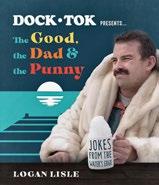
appropriate for non-serious coffee table material.
For now, I’m leaving it in my office, using it as a kind of pick me up when the day gets stressful, the news bleak, and I want to do anything but work. That’s when I can be amused by one of Lisle’s jokes like: “My email password got hacked again. … It’s the third time I’ve had to rename my dog.”
Lisle’s jokes make me smile. And, really, I’m guessing we all could use more things to smile and laugh about.
Dock Tok Presents is available through Amazon, Barnes & Noble and Target.
when you re place your old gas powered lawn e quipment with zero em ission cordless e lectric lawn equipment.



Purchase a new cordless electric lawn equipment device from a store or order online.

Apply for the CLIP program at: EDCCleanAir.org
Receive your approved CLIP application via email. Print approved CLIP application.


Within 30 days of the purchase of the new lawn equipment, take the old gas powered lawn equipment and the approved application to an approved disposal site. Disposal site will sign application and return to you.
Deliver complete application and copy of receipt for new equipment to EDC AQMD in person or via email. (edcaqmd@edcgov.us )

In 4 to 6 weeks, receive a check from El Dorado County AQMD for your incentive!

Applicants must meet specific eligibility requirements:
• Reside and use
•
•
•

No silver bullet for controlling Tahoe Keys aquatic invasive species
After three years of intensely studying how best to remove aquatic invasive species from the Tahoe Keys, including the use of herbicides, much was learned, but no sure-fire treatment plan floated to the top. The main take-aways are several treatments work, but no one method will solve the problem on its own. It’s going to a combination of solutions to kill the plants.
“We want to contain the infestation to protect the rest of the lake,” said Laura Patten, natural resource director with the
hope to develop a management plan this fall that will look at what is possible, what is most strategic, and what can be effective.
Early next year (date to be determined) a public science symposium will be conducted that summarizes all the results from the testing and includes outcomes from this fall’s planning sessions, as well as from discussions taking place on the side. The goal is to create an action plan that includes ways to pay for it.
It’s going to cost big bucks. The threeyear project was funded with $10 million

League to Save Lake Tahoe. “We want to stop fragments from escaping into the lake.”
Scientists and others now have a trove of data from which to move forward. They
from the federal government via the Lake Tahoe Restoration Act, $5 million from the Tahoe Keys Property Owners Association, and $200,000 from the League.
In July, those involved with the Keys’

project hosted a webinar with 88 people listening in.
Called the Control Methods Test or CMT, testing occurred in 2022, 2023 and 2024. It was a collaborative approach with the League, Tahoe Regional Planning Agency, Sierra Ecosystems Associates, and TKPOA the main players.
The Tahoe Keys is the priority because the 170 acres of lagoons contain the largest infestation of aquatic invasive species at Lake Tahoe. Curlyleaf pondweed, Eurasian
(Endothall and Triclopyr) were used.
Other methods included laminar flow aeration (LFA), diver assisted suction harvesting (DASH), bottom barriers, and ultraviolet light. LFA is the only method that had zero effect on target species, while DASH is the only that gets rid ofhe whole plant.
“Some methods only work in midchannel, while others work best in the near-shore,” Lars Anderson, AIS biologist and consultant for TKPOA, said. “Native
Even Lake Tahoe can get sunburned
Usually, the fact that the Lake Tahoe Basin can boast hundreds of days of sunshine a year is a positive, but scientists are proving it’s not necessarily a good thing for the water.
Researchers with the UC Davis Tahoe Environmental Research Center along with peers at Miami University in Ohio analyzed 18 years of data through 2023 to determine the effect ultraviolet radiation has on Lake Tahoe.
They also used specialized equipment to measure UV radiation underwater.
The study was published in May in the Association for the Sciences of Limnology and Oceanography (ASLO).
* No one method works alone
* Large-scale solutions require a combination of methods
* A physical barrier is effective at preventing herbicide movement
* No herbicide entered Lake Tahoe proper
* Some methods only work in mid-channel, while others work best in the near-shore zone
* Methods have varying levels of success for targeting individua linvasive species
* Native plant regrowth occurred with every method applied and increased in herbicide sites
Source: Lars Anderson, consultant
watermilfoil and coontail are the unwanted plants.
“Why do we control these? They have severe impacts to Lake Tahoe; threatening its famed clarity, impairing native habitats and outcompeting our native species (that provide) that delicate food web that Tahoe is famous for. All of that threatens Tahoe’s $5 billion recreation and tourism economy,” Dennis Zabaglo, TRPA’s AIS program manager, said.
An unanticipated scenario arose when in 2022 the water level was low, exposing a large swath of shoreline. The next two years were wetter, with that shoreline then under water.
This revelation means applications will need to be flexible and adaptive.
Scientists believe a 75 percent reduction in AIS will achieve desired water quality levels as well as the ability for native plants to flourish. It’s also a realistic target for non-chemical uses.
2022 was the only year two herbicides
plant regrowth occurred with every method applied and increased in the herbicide sites.”
Forty-six acres were treated each year, which included a seven-acre control site. Applications were used at various sites, including an herbicide-only, and herbicide-UV combo in 2022. The following two years the herbicides were not used and the other methods increased in acreage.
“We had different responses from the different species by the different methods we used. No one method is going to be the solution to the whole problem,” Anderson said. “There are going to be a multiple range of methods that are going to be integrated to make this work.”
Herbicides will likely not be part of the mix going forward due to regulatory and legal barriers. In a lawsuit previously filed by the Sierra Club and others, a judge blocked their use due to inadequate environmental analysis.
“In a wet year, UV radiation penetrates shallower. In a drought year, more UV radiation is slicing through the water. It’s a bit like reducing the lake’s ‘sunscreen,’ making it susceptible to severe sunburn,” the study’s lead author, Shohei Watanabe, said in a statement. He is an associate project scientist with
TERC.
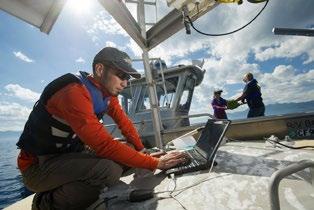
The study found that UV radiation affects the carbon cycle, fish and zooplankton behaviors, and suppresses
photosynthesis, which damages the underwater food web.
The study revealed a hundredfold difference in transparency between the
severe summer drought of 2015 and the extremely wet year of 2023.
“Clearwater lakes are likely to experience increasingly large fluctuations in underwater UV and spectral irradiance due to ongoing climate change and precipitation extremes, with potential impacts on their ecosystem structure and function,” the study says, pointing out the UV issue is not limited to Lake Tahoe.
Researchers believe understanding the impact of UV light and monitoring underwater radiation could help those charged with protecting the health of Tahoe and other lakes.
UV light has been used intentionally at Tahoe to kill aquatic invasive species. Artificial ultraviolet-C light was first tested at Lakeside Marina in 2017 and has since been used in the Tahoe Keys lagoons. UVC from the sun is blocked by the ozone layer while UVA and UVB both penetrate Earth’s atmosphere.


Photo Karin Higgens/UC Davis Shohei Watanabe collects data at Lake Tahoe for the UV study.
Photo Kathryn Reed
The lagoons in the Tahoe Keys in South Lake Tahoe contain more invasive aquatic plants than anywhere else around Lake Tahoe.
I’m normally a nice person
Welcome to August in Tahoe! As always, a marvelously diverse stew of humanity has arrived to trample our spirits, along with the wildflowers. The lake is clogged with rental boats driven by visiting virgin-captains. The meadows are perfumed with a cloud of celebrity jet fuel, and (empty) beer cans and (used) underwear decorate the shoreline of the Truckee River.
Watch the smug assurance as newbies deftly navigate forest trails while balancing a coffee cup in one hand and an iPhone in the other. See spontaneous crowds form when Facebook alerts them that a mother bear is nursing her cubs. Observe how they create a parking lot in your neighborhood—all to spy a juvenile bear crouching in a tree who is just trying to escape the obvious dangers of a human in the throes of social media addiction.
Locals generally retain a positive spirit through it all, yet it inevitably conjures a variety of emotions. It has been pointed out
by A.I. (who literally has no emotions other than an overwhelming desire to smother Elon Musk in his sleep) that this is a natural reaction, as six basic emotions are universal to humans. We rollercoaster from contented happiness with our juvenile activities to sadness over jammed streets and withdrawal from our overcrowded restaurants. Our heart rate rises in fear of real threats like higher home prices and perceived threats, like an invasion of second-homesniffing-trust-funders. Then anger sets in after squandering time in citiot-style waiting lines, with nothing to do but stare at their Lulu, Sweaty-Betty, Sporty & Rich, pretend-outdoorsy butts.
You may find this news surprising, as surprise is the fifth most common emotion. But it is quickly followed by disgust, described as a strong feeling of repulsion to something we find offensive . . like disrespect for a bear’s personal space, workout fashion that costs more than our Subaru loaded with our Specialized moun-

tain bikes on our Kuat bike rack, dodging Captain Confusion, who can’t find the brakes on his rental boat, or avoiding amateurs on the trail who have lost their dog, their coffee cup and their ability to say “hello” to a passing stranger. Yet we retain our empathy for hikers who are unable to walk after the Hoka label rubs off their shoes.
But sometimes locals will trip and plunge right off the “I’m normally a nice person” cliff, crash landing in a pile of malevolent sh*t. This term comes from Latin roots that translates to “males wishing badly,” which I believe is an accurate description of male behavior for the past three million years.
As many of us know, com-

plex emotions can manifest into bad behavior. This is evident in how the high school courtyard’s “mean girls” morph into the pickleball court’s mean old ladies or in politicians who fail the Understanding Basic Human Needs 101 course, which my Labrador passed with flying colors.
So, if you’re one of the emotional cliff divers, take a deep breath and pause before leaping; otherwise, you may find yourself experiencing an overwhelming urge to pinch the cheeks of someone while they’re lecturing you.
This more complex emotional state is referred to as “cute aggression,” commonly seen in serial killers and grandmothers.
For example, a fellow employee once informed me that my “positive attitude was annoying” and proudly stated, “I have done intensive interior work on myself for years. And I’ve come to the conclusion that you need to change.”
I was also doing interior work at the time, debating wheth-
er to pinch, bite or hurl my lunch on her massage-therapist Birkenstocks.
However, it all ended well, as I retained my positive attitude just to annoy her. Because, if you really care about people, that’s what you do.
Which is why I recommend we strive to retain our positive attitude and just keep doing what we do best. Like welcoming visitors to our restaurants with $18 cocktails, challenging them to spend hours searching for a parking spot at Emerald Bay, playing Dodge the Roadwork with them, giving them 20 questions to guess what the Highway 50 center mystery lane is used for.
And be sure to invite them to Fireworks on the Lake, when, right before the show starts, we’ll sink the firework-loaded barge into the lake.
If we can accomplish all these things on a regular basis, then our visiting hordes can bask in all the positivity that Tahoe locals have to offer.

Culture shock: bicycle safety in our community
Last month, I took a deep dive into street design and examined potential pathways for softening our streets to make things safer for pedestrians and cyclists. I plan to stay on that topic. I recently sat down with Nick Speal, president of the Lake Tahoe Bicycle Coalition, to talk about steps that have been taken and his ideas for what work still needs to be done to prevent tragedies like the one that took the life of Giada Lancellotti.
Me: If you look back on the history of the Lake Tahoe Bicycle Coalition, what are the biggest successes the coalition has had in terms of improving outcomes and visibility for cyclists in South Lake Tahoe?
Nick: We're a volunteer nonprofit organization. Our mission is to make Lake Tahoe more bicycle-friendly . . . When there are more people out riding their bikes, it becomes safer and more comfortable for all of us. We do bike valets at a lot of events, making it easier for people to park and ride their bikes to events. We have a bikekitchen program where people donate bikes. We fix them up, teach people how to repair bikes. But what we're here to talk about today is infrastructure. And that's largely the responsibility of the five counties around the lake, the city of South Lake Tahoe, Tahoe Transportation District, Caltrans, and a few other entities that make those decisions. And it's come a long way in the last couple decades. We've gone from quite sparse bike infrastructure to a
place where there are a lot more paths increasingly connected and it's becoming a lot more bikefriendly.
Me: Tell me about some of that interconnection, because that’s really the linchpin on whether biking is even feasible and safe.
Nick: One of the successes that we're excited about is the Dennis T. Machida Memorial Greenway. Decades ago, this was originally planned to be a highway for vehicles cutting from Meyers through the Johnson Meadow to Bijou. It was planned by Caltrans to be a four-lane highway, and the conservancy, led by Dennis T. Machida, decided, “Let's not let that happen.” Now it’s for bikes. Some of the trail has recently been constructed behind LTCC, connecting to the Bijou neighborhood. The vision is to eventually connect Meyers to Van Sickle Park.
Me: That will be amazing, purely for bikes. What about challenges? What has been one of the chief obstacles to improving our bicycle infrastructure?
Nick: It takes a lot of time and a lot of money to build out infrastructure and we have seen a commitment from a lot of our elected leaders to invest here. It just takes time. . We are excited about some of the new infrastructure that's flowing into place now. For example, this summer, they're working on the Green Belts project (which is different from the Greenway), right behind Aleworx at the Y. And also, there’s another [bike
path] near the middle school, through Bijou Park. Those are being constructed this summer. . Part of the challenge of what we're doing is shifting the culture a little bit. As people are changing their habits, changing their ways of getting around, we're trying to show that it's becoming easier and safer to get around by bike. And as more people shift those habits, it becomes easier and more popular. One thing we've been hyper aware of recently is that it doesn't seem like there's enough of a culture here of cars stopping at crosswalks. And really, it is the law. If you see someone waiting to cross a crosswalk, you have to stop in your car and yield to pedestrians and bikes.
I'm not sure if everyone knows about that . . . so we'd love to see that culture change.
Me: How about speed?
What leverage do we have as citizens to drop the speed limit (so we're not sending our kids to school alongside a highway)?
Nick: People understand that it's much safer to have slower speeds. When we had a big group showing up to City Council to protest the potential speed limit increases, the city took a firm stance telling Caltrans that we refused to allow the speed limit to go up. Caltrans did listen, but they raised the speed limit just outside of the city limits. So now, going through the Camp Richardson area, they increased the speed limit, which is crazy to me.
Me: Agreed. So how about some low-hanging fruit that our
City Council could work on, like right now?
Nick: We've got some really great Class I bike paths. South Tahoe Bikeway is great, but infrastructure is expensive and there are other areas where we can move the needle without too much cost. For example, adding some signage and paint and developing Eloise Avenue and other designated bikeways into “bike boulevards” like you see in other cities in California. The speeds are very low. Priority

is given to bikes at intersections, and it feels a lot safer, a lot more welcoming. That would be a small change (to) make South Tahoe a lot more welcoming and safer for bikes and pedestrians.
M.C. Behm is a full-time resident of South Lake Tahoe and author of “Once Upon a Quarantine” and “The Elixir of Yosemite.” Available locally and online. To learn more or respond to columns visit www.behmbooks. com or email mcbehmbooks@ gmail.com


Photo MC Behm
Nick Speal is the president of the Lake Tahoe Bicycle Coalition

Biking through history
Riding my bike to work, my e-bike rat rod, as I like to call it—a 1950s Columbia Goodyear Highway Patrol with a nice rust patina over the whole bike, completely original except for the electric motor I added. Yes, I do occasionally ride an e-bike, only on the road and only to avoid driving my car. Anyway, I am passing by the Bijou Bike Park, enjoying my commute, when I notice this guy pedaling harder than most towards one of the jumps on the big line; he sends it off the lip and throws
a beautiful, slow-motion (it seemed to me) back flip and lands it perfectly! Oh, that just made my morning…and what about his morning!? Then a split second later this road bike dude, fully decked out and standing up sprinting, goes flying past me on the street—wow, what a cool bike culture moment.



It’s amazing when you think about the way we all started this two-wheeled thing. Mostly as children, we are taught by our parents or a friend. Most, in years past, used training wheels, which I would say was a bad method compared to today’s “strider” bikes. The funny thing is, that style of two wheels with no pedals, propulsion by simply pushing along with feet on the ground, is the way the first bike was made. In 1817, Baron Von Drais invented the Laufmachine or “running machine,” later known as the velocipede, a strider for adults . . very rich adults.
When we were little, we all went through this learning period spanning from days to weeks— some frustration, fear, excitement, crashes and then magic when suddenly we glided along so smooth and fast and free! I remember that moment when my dad removed my training wheels. Running along behind me, he finally took his hand off the back of my bike and I rode, farther than ever! I was so excited…that I crashed. In modern times we learn to ride bikes as kids simply to have fun and for most, that remains
our reason for riding. There are other motivations like transportation, helping the environment or even to make a living like bike messengers (who seem to be disappearing these days). But historically, bikes have played some very important roles in shaping society.
A great example of this “shaping” was in the late 1800s when women were relegated to spending their days at home, working with little to no mobility unless the husband took them somewhere. At some point (of frustration, I would think), women began to learn to ride bikes. This gave them unprecedented freedom and mobility, creating a wonderful, major shift in society, and even played an important part in the Suffrage movement. But as women rode more, they realized the ankle length dresses and petticoats they were expected to wear in public just wouldn’t work on a bike, so they started making them shorter and wearing bloomers under the short dress, which eventually turned into knickerbockers. This completely changed the way women dressed.
Susan B. Anthony said that bicycling “has done more to emancipate women than anything else in the world,” and added, “I rejoice every time I see a woman ride by on a wheel…the picture of free, untrammeled womanhood.”
There were many situations
during wartime, especially during the two world wars, when bikes were used because soldiers and messengers on foot, horseback or heavy machinery just couldn’t move as quickly, quietly and efficiently. After the Civil War, around 1866, the army formed the first bicycle mounted division, the 25th Infantry of the Buffalo Soldiers, who rode thousands of miles with and without roads, through all types of weather and terrain. And you thought mountain bikes were a modern creation.
During the late 1800s, another key role bikes played was to move towards road improvements. Horses and their carriages just beat the crap out of (or is that beat the crap into?) roads, though not enough cars were around yet to really matter. But then bicycles helped that situation, too, because much of the manufacturing technique and machinery came first from the bicycle industry, which then influenced the motorcycle and then automotive industry. That whole progression interests me a lot but there isn’t enough room for it here. I will say it’s kinda cool that bicycles gave life to the auto industry and now bicycles are taking life away from the auto industry.
Let’s play!














Photo Gary Bell
How 'bout this hybrid?

Vampires
and former loves
The Guardian recently had a feature where their writers were taking turns writing about their ultimate feel-good movies. These are their go-to films that they can watch over and over. I think all of us have a feel-good or comfort film. You know, when you’ve had a bad day or are upset or depressed about something, it’s a film you can watch and it will help you feel better. Or even just a rainy day and you’re inside and want to relax with something that you know and enjoy. It could be a romantic comedy, a childhood favorite or a


classic old film. Or it could be an adventure or horror film or a drama. And you can watch it over and over. As I have mentioned in earlier columns, our connection to any film is purely subjective. Though we might have reactions that are similar to other people, each film will still say something to us that other people may not experience. Many folks have a comfort film that comes with the holidays, and so becomes a tradition, such as It’s a Wonderful Life or Miracle on 34th Street at Christmas time. Teresa’s favorite film is Love Actually which we watch every Christmas. But a real comfort film is one you can watch at any time and many times. As we get older, it may change as we grow and see more films. My current ultimate feel-good film is the 1996 Twister. I have always loved disaster films in general and especially ones that stay closer to real life. In Twister I love the effects, all the characters and the sense of danger hanging over it all. It’s just fun to watch. So, what is your ultimate feelgood film?
This month I have two films that are very different from each other. The first is Sinners. It hit the theatres last April, but also just came out on HBO/Max. Sinners is a wildly entertaining mix of genres with great music. It starts with twin brothers, Smoke and Stack, coming home to Mississippi in 1932, having served in WWI and then lived in Chicago. After learning some of the more sophisticated gangland practices in Chicago, the two return to the small Black community where they grew up, where life is tenuous in the Jim Crow South.
The two pick up where they left off, and with a bag of mysterious cash, purchase an old factory they will turn into a juke joint for the local population. They bring in some of their friends, including their young cousin Sammie, a blues guitar player with a soulful voice and an old piano/harmonica player called Delta Slim, promising him he can have all the free beer he wants. There are some relationships to mend or rekindle as
well as old grudges to address.
Just as the place has its grand opening, the film takes a ninety-degree turn, becoming more like From Dusk Till Dawn as the club attracts some vampires who have made their way to town, and what started as a nice period drama shifts into a vampire movie with all the patrons of the club trying to stay alive until dawn. And these are the kind of vampires that multiply quickly. As soon as someone gets bitten, they become a vampire like within like five minutes. And these are not delicate, sexy bloodsuckers; these are the “rip into your throat violently” type of vampires.
Even with vampire mayhem, the film never loses its feel for the period, the culture or the music and there is an overlaying feel of magic and allegory. It all blends into a luscious whole and the ride is worth the price of admission.
Smoke and Stack are both played by Michael B. Jordon, and both personas energize the story.
The cinematography engulfs the passions of the characters with beautifully crafted visuals. Overall, Sinners is great storytelling with love, action, horror, and great music. Teresa missed this one.
For something completely different there is The Ballad of Wallis Island now on Prime. Wallis Island is a small fictional island off the coast of Wales. The only way to get there is by a very small boat that comes to the island intermittently. There isn’t even a marina or dock, so visitors have to wade ashore from where the boat stops.

BE AWARE BE PREPARED
As we continue doing the work to make our system more resilient to extreme fire conditions, we also use three key strategies to safeguard our communities against the threat of wildfires. While these measures help to keep us all safe, they can lead to power outages. We want everyone to be aware and prepared.

The film starts with folk musician Herb McGwyer wading ashore with luggage and guitar, wondering how he got booked for a gig on this small island. Herb is one half of McGwyer and Mortimer, a folk duo that had fair success back in 2009, but then split up to go their separate ways. He meets up with Charles, an eccentric inhabitant of the island, who is a huge fan of McGwyer and Mortimer and who hired Herb for an obscene amount of money. It turns out that Charles is not only a lottery winner but has actually won the lottery twice.
As Herb settles in to Charles’ house, (because the island has no hotels) he realizes that he is to play a concert for an audience of one.
And not only that, but Charles has also invited (unbeknownst to Herb) Herb’s former partner, Nell Mortimer, to also come and sing, hoping to reunite his favorite folk group.
But things will not be that easy as old relationships cannot simply rekindle, and on a small island, which is not easy to get off of, Herb and Nell have to deal with each other while Charles tries to salvage his dream concert.
Overall, The Ballad of Wallis Island is an easy-moving, bittersweet comedy with an emotional punch. It has some predictable directions, but they don’t detract from well-grounded characters and the thought of how we capture and try to hang on to moments of time in our lives. Teresa really enjoyed it.
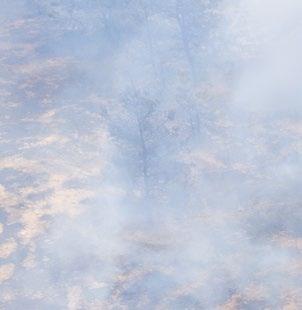
1| 2| 3|
FIRE SEASON SETTINGS
Sensitive settings on power lines to reduce wildfire risk.
PUBLIC SAFETY OUTAGE MANAGEMENT

Proactive de-energization ahead of extreme wildfire risk conditions.
EMERGENCY DEENERGIZATION

Turning off the power when a wildfire gets too close to power lines to protect first responders and prevent secondary fires.
Visit nvenergy.com/PowerSafeNV to learn more about these strategies and how to be prepared for extended outages during this time of heightened fire risk.
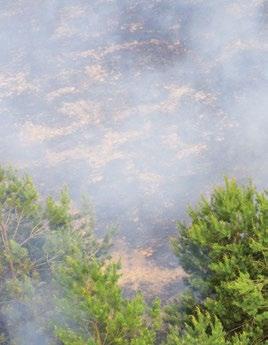




Photo Focus Features
Carey Mulligan plays one half of a former musical and romantic duo in The Ballad of Wallis Island.

ABC Mini Storage
Medicaid cuts: less money, crowded ER
With
Barton
“We do not know how many patients will be affected by the new Medicaid/ Medi-Cal eligibility rules,” Barton CFO Kelly Neiger said.
According to Data USA, 20 percent of South Lake Tahoe residents are on Medicaid, 12.3 percent in the whole of El Dorado County, and 9.21 percent in all of Douglas County.
The Congressional Budget Office estimates by 2034 reductions in federal support for Medicaid and the Affordable Care Act will mean the loss of insurance for nearly 12 million people because Medicaid funding will be cut by about $911 billion in the next 10 years.
Options for people include getting commercial insurance or not having any.
“Those without health insurance are





more likely to delay needed care or seek treatment in the emergency department.
Based on this shift, we expect the number of emergency department visits could increase,” Neiger said. “Barton’s emergency department provides care to all patients—no one is turned away regardless of their ability to pay.”
Other options locally include Barton Community Health Center, which sees patients who may not have insurance and offers a sliding scale for services to patients paying cash.
More providers are being sought there so care can be provided seven days a week.
“Additionally, Barton has a financial assistance program to help those who may have challenges with payments,” Neiger said. “El Dorado County provides a MediCal enrollment counselor, who is located inside Barton Memorial Hospital, to assist patients in understanding their options and completing enrollment. Barton also offers financial counseling to help individuals navigate coverage changes and determine the best path forward for their health and financial needs.”
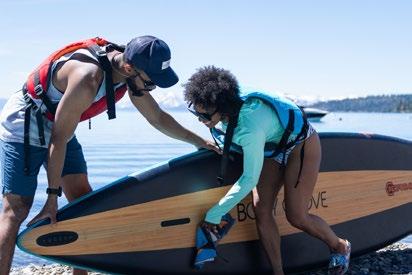






















Photo Lake Tahoe Water Trail

